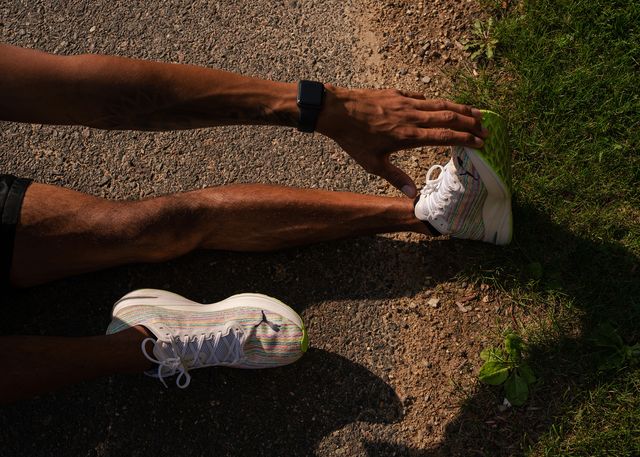
You don’t need us to tell you that running has a ton of health benefits, but like all the best things in life (relationships, children, travel), it also causes stress from time to time, particularly on your feet. And if you’ve ever been plagued with nagging arch pain from running, well you’re not alone. There are typically three main causes of foot arch pain, so pay attention because some of them you definitely don’t want to continue running with.
“Each category of running can place its own demand on the foot, and more specifically on the arch,” says Loretta Logan, a doctor of podiatry and associate professor at the New York College of Podiatric Medicine & Foot Center of New York. Trail runners, for instance, need to deal with the constantly changing terrain, which can stress the plantar fascia, and thus the arch, Logan says; while running uphill puts more demand on the ankle, which can create tension in the arch; and the impact of sprinting can also strain the plantar fascia.
Of course, trail running, hill training, and sprinting are all things you should do. But if you’ve noticed a pesky pain in the arch of your foot, you need to address it ASAP. The first step in eliminating your foot-arch pain starts here. Below are the three most common causes of pain in the arch of the foot and what you can do about it.
1. Plantar Fasciitis
If you feel pain when you first step out of bed in the morning, or after long periods of rest, you might have plantar fasciitis, a.k.a. inflammation of the plantar fascia, a thick tissue on the bottom of your foot. Even though pain typically presents itself in the heel, you may also feel it in the arch since the tissue runs along the whole foot. “When the plantar fasciitis is put under too much stress (say, from increasing your mileage too much, too soon), you’ll experience pain in the inside part of the heel bone,” Logan says.
What to do: Mild plantar fasciitis can be treated with time off, some simple exercises like these, an ice bath, and maybe even some new shoes. No dice? “You may need ‘extracorporeal shock wave therapy’ (sound waves that stimulate healing) or surgery,” Logan says. Yeah, not fun. Next time, be sure to increase your mileage and intensity gradually (a solid rule of thumb: don’t increase your mileage by more than 10 percent a week) and stretch your calves before hitting the pavement. Tight calf muscles can put stress on the foot and fascia, Logan says.
2. A Stress Fracture
Repeated stress (like the continuous pounding of running) can cause a tiny break in the bone, also known as a stress fracture. “The metatarsal bones, which make up the front part of the arch, are a common area for stress fractures with the second and third metatarsals being affected most often,” Logan says. “The pain is typically felt at a specific and localized spot, usually on the top portion of the bone.” Sadly, your stress fracture might not be obvious at first, which puts you at risk for making it worse: “The pain may be mild at first, but it can intensify with time if you don’t take care of it.”
What to do: “Stress fractures take about six to eight weeks to heal and are routinely treated with rest, ice, compression, and elevation,” Logan says. Rest is key here: “Ice and NSAID medication may assist in early days, but the fastest pathway to healing is through relative off-loading of the fracture site.” To be clear, that means no running until your doc says so. Some doctors may even prescribe a walking boot to help take some load off the affected area. The stakes are high: A stress fracture can turn into a fracture-fracture (or full break) if you aren’t careful.
And like with plantar fasciitis (and pretty much all running injuries, for that matter), you can prevent future stress fractures by upping your mileage gradually. “If you’re running on uneven or rough terrain you should wear a shoe with a rugged outer sole,” Logan adds. We like these trail running shoes.
3. Tendonitis
“The posterior tibial tendon is the main tendon supporting the arch on the inner side of the foot,” Logan says. “When the tendon is overworked and inflamed, you’ll feel a throbbing or burning pain along your arch during and/or after running.” You might also notice swelling or have pain that extends to your ankle.
What to do: Don’t mess with this one: “This could slowly collapse the arch of the foot if it isn’t treated properly,” Logan says. See your doctor to confirm your diagnosis, but treatment will likely involve stretching the tendon by pointing your foot down, then to the side. (“Like you’re pushing down on a gas pedal, then in towards the break,” Logan says.) Do 3 sets of 10.